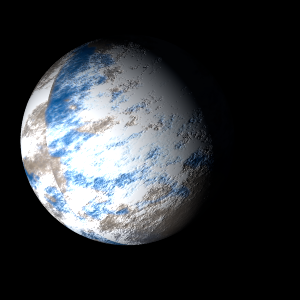|
|
Space Astro
|
Info for exoplanet "Kelind Porie"
| Scientific (actual) data |
|---|
| Name | Kepler-158 c |
| Planet status | Confirmed |
| Radius | 0.17 |
| Orbital period | 28.5514 |
| Semi major axis | 0.158 |
| Discovered | 2014 |
| Updated | 2021-02-05 |
| Tconj | 2455020 |
| Impact parameter | 0.61 |
| Publication | Announced on a website |
| Detection type | Primary Transit |
| Alternate names | 2MASS J18560773+3946527 c, K00446.02, KIC 4633570 c, KOI-446 c, KOI-446.02, WISE J185607.76+394653.3 c |
| Star name | Kepler-158 |
| Right ascension | 284.03° |
| Declination | 39.78° |
| Mag j | 12.722 |
| Mag h | 12.138 |
| Mag k | 12.057 |
| Star distance | 315.177 |
| Star metallicity | -0.03 |
| Star mass | 0.73 |
| Star radius | 0.65 |
| Star sp type | K4V |
| Star age | 3.98 |
| Star temperature | 4628 |
| Star alternate names | KIC 4633570, WISE J185607.76+394653.3, KOI-446, 2MASS J18560773+3946527 |
| Wikipedia article | Kepler-158 c |
Back
| |
| Fictional info (?) |
|---|
| Suggested name | Kelind Porie |
| Planet type | Planet |
| As seen from Kepler-158, in a frame of reference that rotates with the orbital motion, it appears to rotate only once every two years.
It was the one of the first exoplanets visited by a spacecraft, and one of the first to be successfully landed on. |
| Atmosphere | Carbon dioxide | 44% |
| Carbonyl sulfide | 35% |
| Argon | 21% |
| 2H2O | 0.094% |
| Hydrogen peroxide | 0.034% |
| Atmospheric pressure | 12 bar |
 |
| Moon | Puckrhea Ebe | Very small almost round rocky asteroid |
| Tilinte Saxa | Large slightly egg-shaped gaseous planetoid |
| Thys | Huge round rocky moon |
| Google search for Kelind porie |
|
Website by Joachim Michaelis
|
|
|
|